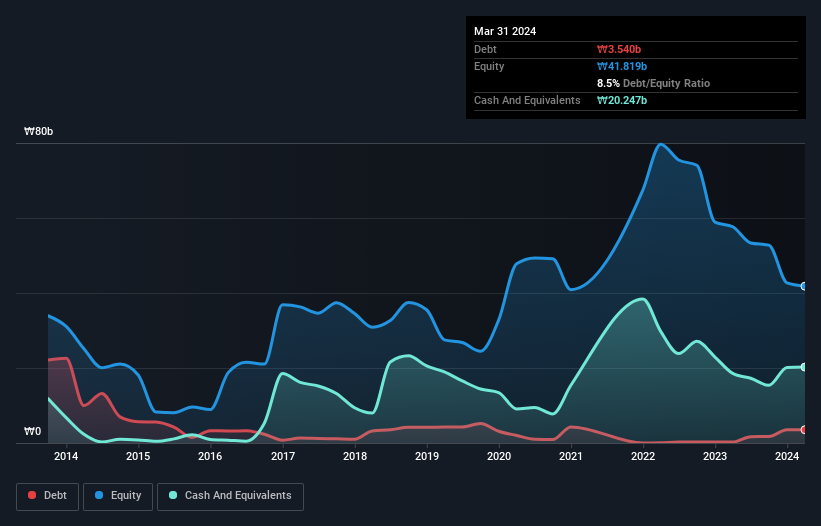The external fund manager backed by Berkshire Hathaway's Charlie Munger, Li Lu, makes no bones about it when he says 'The biggest investment risk is not the volatility of prices, but whether you will suffer a permanent loss of capital.' So it seems the smart money knows that debt - which is usually involved in bankruptcies - is a very important factor, when you assess how risky a company is. As with many other companies Barunson Co., Ltd. (KOSDAQ:018700) makes use of debt. But the more important question is: how much risk is that debt creating?
When Is Debt Dangerous?
Debt assists a business until the business has trouble paying it off, either with new capital or with free cash flow. In the worst case scenario, a company can go bankrupt if it cannot pay its creditors. However, a more common (but still painful) scenario is that it has to raise new equity capital at a low price, thus permanently diluting shareholders. Of course, the upside of debt is that it often represents cheap capital, especially when it replaces dilution in a company with the ability to reinvest at high rates of return. When we think about a company's use of debt, we first look at cash and debt together.
Check out our latest analysis for Barunson
How Much Debt Does Barunson Carry?
As you can see below, at the end of March 2024, Barunson had ₩3.54b of debt, up from ₩251.5m a year ago. Click the image for more detail. However, it does have ₩20.2b in cash offsetting this, leading to net cash of ₩16.7b.

A Look At Barunson's Liabilities
We can see from the most recent balance sheet that Barunson had liabilities of ₩17.5b falling due within a year, and liabilities of ₩5.11b due beyond that. On the other hand, it had cash of ₩20.2b and ₩7.21b worth of receivables due within a year. So it can boast ₩4.80b more liquid assets than total liabilities.
This surplus suggests that Barunson has a conservative balance sheet, and could probably eliminate its debt without much difficulty. Succinctly put, Barunson boasts net cash, so it's fair to say it does not have a heavy debt load! The balance sheet is clearly the area to focus on when you are analysing debt. But you can't view debt in total isolation; since Barunson will need earnings to service that debt. So if you're keen to discover more about its earnings, it might be worth checking out this graph of its long term earnings trend.
Over 12 months, Barunson reported revenue of ₩62b, which is a gain of 7.7%, although it did not report any earnings before interest and tax. That rate of growth is a bit slow for our taste, but it takes all types to make a world.
So How Risky Is Barunson?
We have no doubt that loss making companies are, in general, riskier than profitable ones. And in the last year Barunson had an earnings before interest and tax (EBIT) loss, truth be told. Indeed, in that time it burnt through ₩3.0b of cash and made a loss of ₩16b. But the saving grace is the ₩16.7b on the balance sheet. That means it could keep spending at its current rate for more than two years. Even though its balance sheet seems sufficiently liquid, debt always makes us a little nervous if a company doesn't produce free cash flow regularly. The balance sheet is clearly the area to focus on when you are analysing debt. But ultimately, every company can contain risks that exist outside of the balance sheet. Case in point: We've spotted 2 warning signs for Barunson you should be aware of, and 1 of them shouldn't be ignored.
Of course, if you're the type of investor who prefers buying stocks without the burden of debt, then don't hesitate to discover our exclusive list of net cash growth stocks, today.
Valuation is complex, but we're here to simplify it.
Discover if Barunson might be undervalued or overvalued with our detailed analysis, featuring fair value estimates, potential risks, dividends, insider trades, and its financial condition.
Access Free AnalysisHave feedback on this article? Concerned about the content? Get in touch with us directly. Alternatively, email editorial-team (at) simplywallst.com.
This article by Simply Wall St is general in nature. We provide commentary based on historical data and analyst forecasts only using an unbiased methodology and our articles are not intended to be financial advice. It does not constitute a recommendation to buy or sell any stock, and does not take account of your objectives, or your financial situation. We aim to bring you long-term focused analysis driven by fundamental data. Note that our analysis may not factor in the latest price-sensitive company announcements or qualitative material. Simply Wall St has no position in any stocks mentioned.
About KOSDAQ:A018700
Barunson
Produces, distributes, and invests in cultural contents in South Korea.
Excellent balance sheet and slightly overvalued.
Market Insights
Community Narratives



